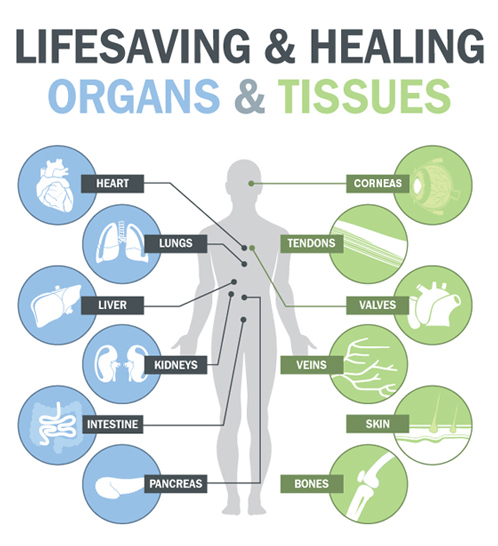GENERAL DONATION
Infographic courtesy of Donor Alliance Organ & Tissue Donation.
One organ and tissue donor can save and/or enhance the lives of up to 75 people.
MATCHING ORGANS
The United Network for Organ Sharing (UNOS) maintains a centralized computer network, which links all organ procurement organizations (OPOs) and transplant centers.
The centralized computer network matches donated organs with transplant candidates in ways that save as many lives as possible and provide transplant recipients with the best possible chance of long-term survival.
The matching criteria, developed by the transplant community, is programmed into UNOS’ computer matching system. Only medical and logistical factors are used in organ matching. Personal or social characteristics such as celebrity status, income or insurance coverage play no role in transplant priority.
The centralized computer network matches donated organs with transplant candidates in ways that save as many lives as possible and provide transplant recipients with the best possible chance of long-term survival.
The matching criteria, developed by the transplant community, is programmed into UNOS’ computer matching system. Only medical and logistical factors are used in organ matching. Personal or social characteristics such as celebrity status, income or insurance coverage play no role in transplant priority.
WHAT DETERMINES WHO WILL BE OFFERED AN ORGAN?
Depending on the organ, there are many considerations. These include but are not limited to:
• age
• blood type
• medical urgency
• waiting time
• geographic distance between donor and recipient
• size of the donor organ in relation to the recipient
• type of organ needed
• age
• blood type
• medical urgency
• waiting time
• geographic distance between donor and recipient
• size of the donor organ in relation to the recipient
• type of organ needed
5 DONATION PATHWAYS high level overview
ORGAN TYPE AND WAITING TIME
Most candidates, except those with living donors, wait for an organ due to the shortage of donor organs. Because each candidate's situation is unique, waiting times can vary, depending on a number of factors, such as those described below.







